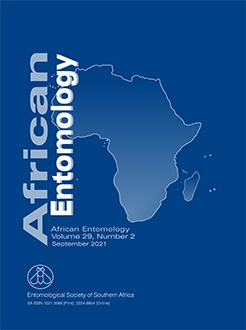To control adults of the red palm weevil (RPW), Rhynchophorus ferrugineus (Olivier) (Coleoptera: Curculionidae), a pheromone Bio-Trap® containing the commercial formulation of Beauveria bassiana (Broadband™) was integrated with neem-based insecticide, (azadirachtin). Beauveria bassiana at 40 ml suspension of 1 × 109 spores/ml caused 100% mortality of RPW. The LC50 of neem-based insecticide, (azadirachtin) to RPW by direct spraying was 1810.3 ppm, whereas that by feeding was 2117.80 ppm. The lowest concentration of neem that was 100 % repellent to RPW was 800 ppm. The repellency effect of neem was integrated with the pheromone Bio-Trap in three net houses (5 × 5 m), each planted with five offshoots of palm trees (height, 1–1.5 m). In two of the net houses, wounds were made on offshoots and sprayed weekly with 800 ppm neem, and a pheromone Bio-Trap was introduced. The third net house was the control, in which wounds were made on the offshoots without the spraying of neem and a pheromone non-Bio-Trap (without fungus) was introduced. Thirty adults were introduced, and after 30 days in the net houses with the pheromone Bio-Trap, all RPW died because of contamination by fungi. The repellency of neem prevented the insects from laying eggs in the wounded offshoots, and no larvae were found. However, in the control net house, only 60 % of the adults were trapped and killed in the pheromone non-Bio-Trap, and two of the five offshoots were infested with 26–34 larvae.
How to translate text using browser tools
28 September 2021
Integration of Repellency Effect of Neem-Based Insecticide and Pheromone Bio-Trap® with Beauveria bassiana (Hypocreales: Cordycipitaceae) to Control the Red Palm Weevil, Rhynchophorus ferrugineus (Olivier) (Coleoptera: Curculionidae)
M.J. Hajjar,
A.M. Ajlan,
M.H. Al-Ahmad
ACCESS THE FULL ARTICLE
It is not available for individual sale.
This article is only available to subscribers.
It is not available for individual sale.
It is not available for individual sale.

African Entomology
Vol. 29 • No. 2
September 2021
Vol. 29 • No. 2
September 2021
azadirachtin
biological agents
botanical insecticide
invasive insect
IPM





